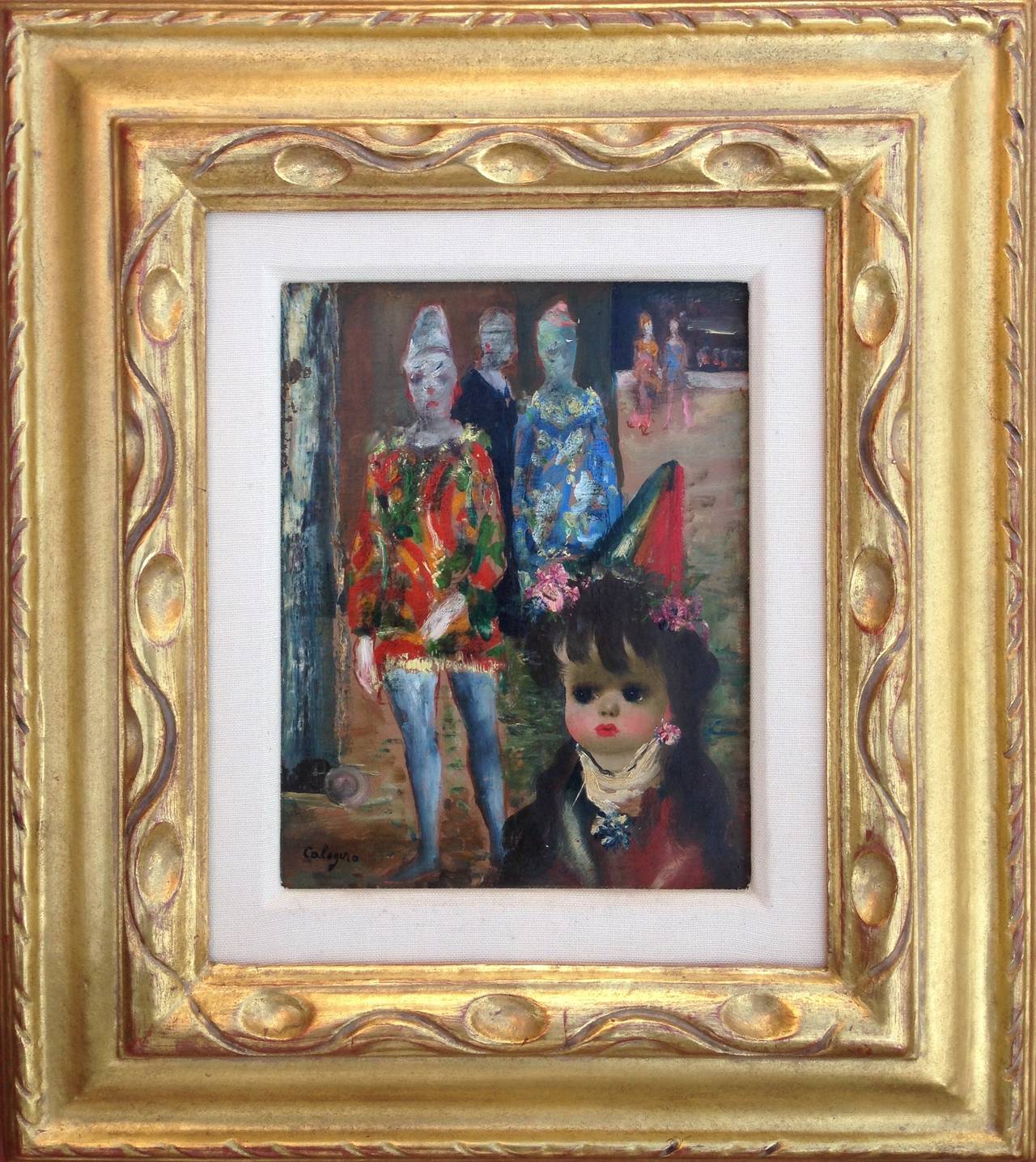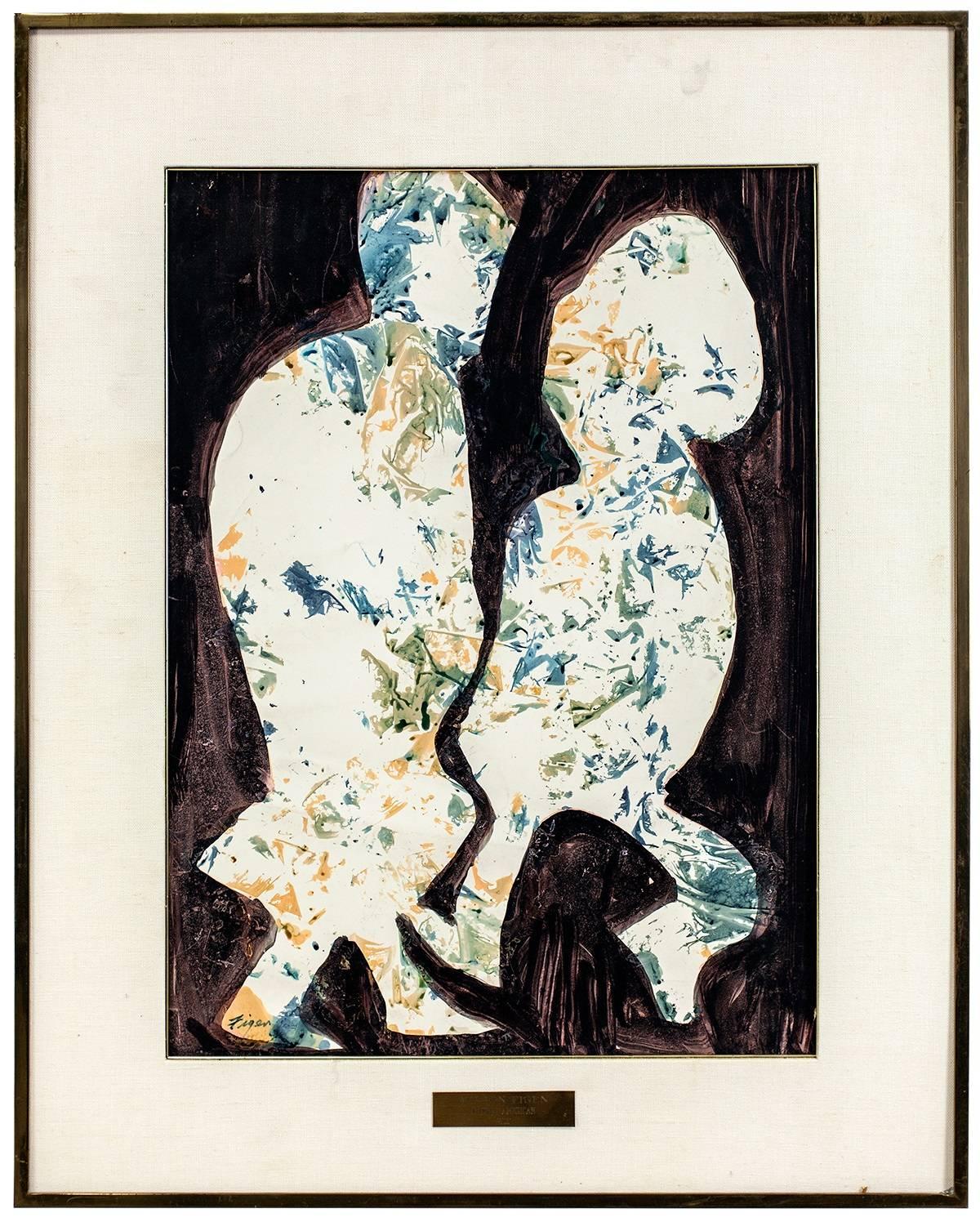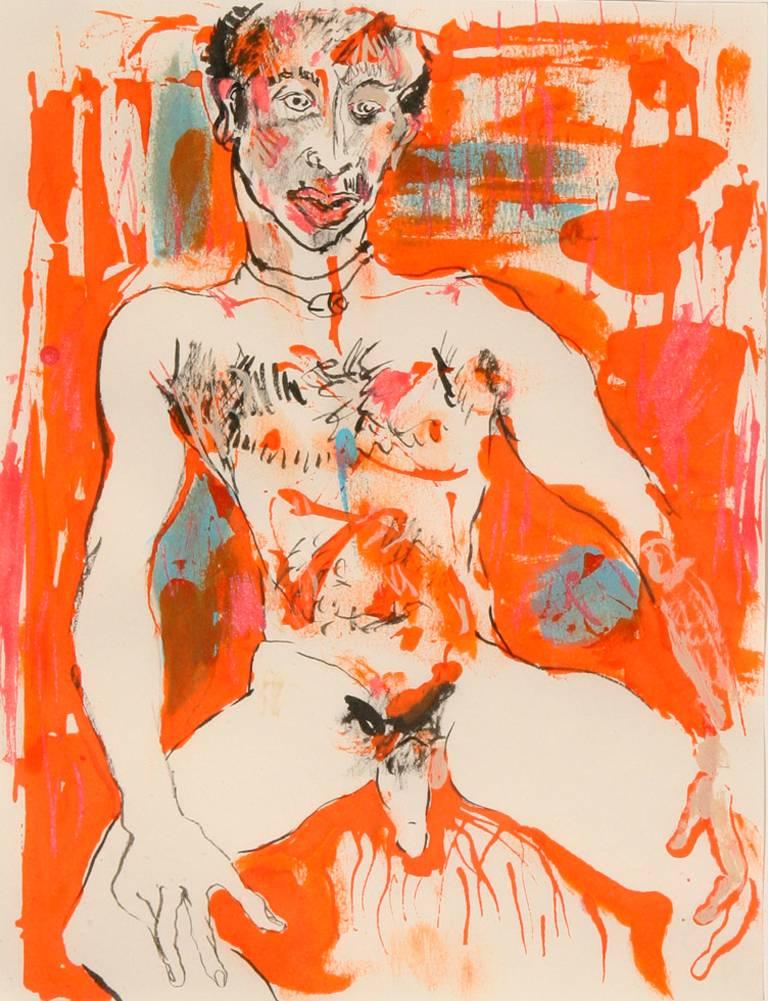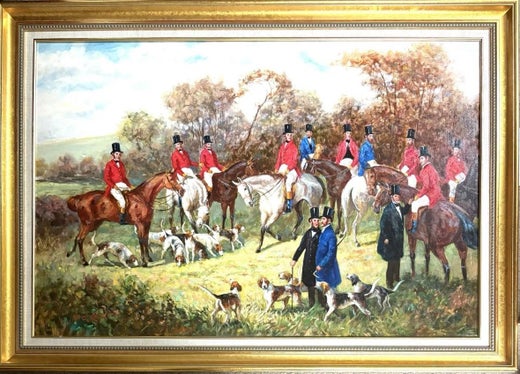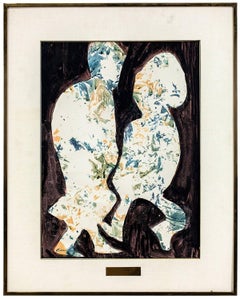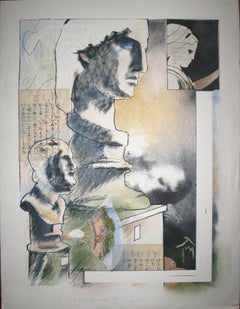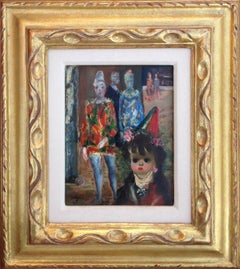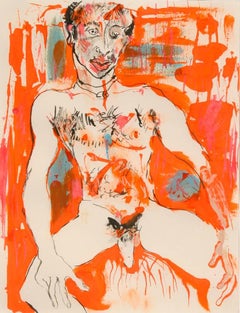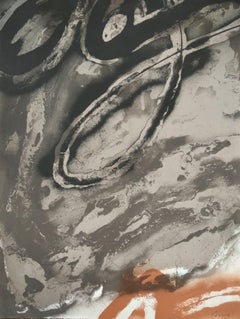Items Similar to Love Careless Love
Want more images or videos?
Request additional images or videos from the seller
1 of 8
Jack LevineLove Careless Love
$950
£721.22
€824.93
CA$1,327.29
A$1,476.23
CHF 770.84
MX$17,964.19
NOK 9,844.85
SEK 9,232.73
DKK 6,156.74
Shipping
Retrieving quote...The 1stDibs Promise:
Authenticity Guarantee,
Money-Back Guarantee,
24-Hour Cancellation
About the Item
Born to Lithuanian Jewish parents, Levine grew up in the South End of Boston, where he observed a street life composed of European immigrants and a prevalence of poverty and societal ills, subjects which would inform his work. He first studied drawing with Harold K. Zimmerman from 1924-1931. At Harvard University from 1929 to 1933, Levine and classmate Hyman Bloom studied with Denman Ross. As an adolescent, Levine was already, by his own account, "a formidable draftsman". In 1932 Ross included Levine's drawings in an exhibition at the Fogg Art Museum at Harvard, and three years later bequeathed twenty drawings by Levine to the museum's collection. Levine's early work was most influenced by Bloom, Chaim Soutine, Georges Rouault, and Oskar Kokoschka. Along with Bloom and Karl Zerbe, he became associated with the style known as Boston Expressionism.
- Creator:Jack Levine (1915, American)
- Dimensions:Height: 25.5 in (64.77 cm)Width: 31 in (78.74 cm)
- Medium:
- Period:
- Condition:minor scratches on frame.
- Gallery Location:Surfside, FL
- Reference Number:1stDibs: LU38210791022
Jack Levine
Jack Levine was an American social realist painter and printmaker, born and raised in Boston. He enrolled in art classes at the Museum Fine Arts School of Boston and came under the influence of Dr. Denman Ross of Harvard University, who recognized his talent and gave him free art lessons. He was especially interested in the Old Masters, at the Fogg Museum, at Harvard. In 1935, he became a W.P.A. artist, using his experience growing up in a lower-class neighborhood, in his subject matter.
About the Seller
4.9
Platinum Seller
Premium sellers with a 4.7+ rating and 24-hour response times
Established in 1995
1stDibs seller since 2014
1,784 sales on 1stDibs
Typical response time: <1 hour
- ShippingRetrieving quote...Shipping from: Surfside, FL
- Return Policy
Authenticity Guarantee
In the unlikely event there’s an issue with an item’s authenticity, contact us within 1 year for a full refund. DetailsMoney-Back Guarantee
If your item is not as described, is damaged in transit, or does not arrive, contact us within 7 days for a full refund. Details24-Hour Cancellation
You have a 24-hour grace period in which to reconsider your purchase, with no questions asked.Vetted Professional Sellers
Our world-class sellers must adhere to strict standards for service and quality, maintaining the integrity of our listings.Price-Match Guarantee
If you find that a seller listed the same item for a lower price elsewhere, we’ll match it.Trusted Global Delivery
Our best-in-class carrier network provides specialized shipping options worldwide, including custom delivery.More From This Seller
View AllSLR
By Milton Figen
Located in Surfside, FL
Milton Figen 'SLR', Mid-Century Modernist Figurative Acrylic on Paper, SIGNED.
Category
Late 20th Century Modern Figurative Paintings
Materials
Paper, Ink, Acrylic
$1,200
Untitled
By Stephen Greene
Located in Surfside, FL
Stephen Greene (September 19, 1917 – November 18, 1999) was an American artist known for his abstract paintings and in the 1940s his social realist figure paintings. Stephen Greene was born in New York City and he attended the National Academy School of Art and then the Art Students League.
Mr. Greene taught at Princeton University for many years where he was teacher to many well-known figures in the art world including Frank Stella and art critic and historian Michael Fried. Mr. Greene had more than 2 dozen solo exhibitions of his work in leading art galleries in New York City. He also taught at the Art Students League of New York for several decades. After the mid-1950s and until his death Greene's mature work was related to abstract expressionism, color field painting and surrealism. His work is represented in numerous public collections, including the Museum of Modern Art, the Metropolitan Museum of Art, the Whitney Museum of American Art, the San Francisco Museum of Modern Art, the Brooklyn Museum, the Houston Museum of Fine Arts...
Category
20th Century Contemporary Abstract Prints
Materials
Silver Gelatin
"Untitled"
By Dan Reisinger
Located in Surfside, FL
Reisinger was born in Kanjiža, Serbia, into a family of painters and decorators active in Austria-Hungary and the Balkans. Most family members died in the Holocaust, including his father. As a teenager, he became active in the Partisan Pioneer Brigade and, with his mother and stepfather, immigrated to Israel in 1949. Reisinger initially lived in a transit camp and then worked as a house painter in order to earn money from almost any source. In 1950 at age 16, he was accepted as a student—its youngest up to the time—at the Bezalel Academy of Art and Design in Jerusalem, there to 1954.
During mandatory service in the Israeli Air Force from 1954, he was the art director of its books and other publications. While there, he attended a class on postage-stamp design taught by Abram Games, who became his mentor and friend. Subsequently, he traveled, studied, and worked in Europe: from 1957 in Brussels and then onto London where, 1964–66, studied stage and three-dimensional design at the Central School of Art and Design, designed posters for Britain's Royal Mail, and worked for other clients while making intermittent visits to Israel. Then in 1966, he returned permanently to Israel and established a studio in Tel Aviv and today in Giv'atayim.
His work has been included in numerous international group and one-person exhibitions. A large number of social-, political-, and cultural-theme posters and other graphic design, such as calendars, packaging, and more than 150 logos are superior to much of his fine art. He designed a new logo for El Al airlines (1972), and the 50-meter-long aluminum-cast relief (1978) of a biblical quotation in Hebrew on the exterior of the Yad Vashem, Israel's official museum/memorial to Holocaust victims, in Jerusalem. He has also designed logos for the Tel Aviv Museum of Arts, Tefen Museum of Arts, and Habima Theater (הבימה - התיאטרון הלאומי) and the symbol and posters of the 9th-15th Maccabiah Games (מַכַּבִּיָּה).
His widely published self-produced “Again?” poster (1993) features a Nazi swastika (which Reisinger incorrectly made to face left) breaks apart to 5 pointed red Star of soviet union in reference to the possible dreaded repeat of the Holocaust. The influences on his work—itself more widely focused than solely on social and political issues—have come from colorists, Minimalists, Constructivists, and humorists. He claims one of his more significant contributions has been to stretch the visual and communicative possibilities of Hebrew letters through his symbols and logos. Reisinger is one of Israel's most-accomplished graphic designers; the others include Franz Kraus...
Category
20th Century Contemporary Abstract Prints
Materials
Screen
A Matter of Aesthetics
Located in Surfside, FL
Lithograph with Roman portrait bust.
Will Petersen, a painter, master printer and a poet, was born in
Chicago. (Amer. 1928-1994) created this limited edition LITHOGRAPH at
the Lakeside Studio.
The LITHOGRAPH PRINT is from a limited edition THE LITHOGRAPH IS SIGNED TITLED AND ANNOTATED
BY THE ARTIST in pencil EXCELLENT condition.
Will's formal art education began with classes at the Chicago Academy
of Fine Arts. As a student at the city's Steinmetz High School,
Petersen succeeded Hugh Hefner (of Playboy magazine fame) as the HS
newspaper cartoonist, the Steinmetz Star. During this time, Petersen
recovered from polio.
In 1947 Petersen enrolled at Chicago's Wilbur Wright College. While
there, he painted with oils for the first time. Two years later he
enrolled at Michigan State University where he developed a strong
interest in literature and writing and began printmaking. By 1951 he
had begun to exhibit paintings and prints nationally. A year later he
completed his master's degree.
Petersen served in the United States Army from 1952-54, spending one
year as an education specialist in Japan. This encounter with the
Japanese culture affected his entire life. He became interested in
calligraphy and Noh, classical Japanese Buddhist performance that
combines elements of drama, music and poetry. Upon completion of his
military service in Japan in 1955, Will Petersen settled in Oakland,
California, where he met some of the most active poets of the Beat
Generation: Gary Snyder, Allen Ginsberg, Jack Kerouac, Phil Whalen,
Mike McClure and others. Petersen was attracted to the group by their
intelligence and belief in Zen Buddhism.
In 1956 in his small studio in Oakland, he printed the poems of Jack
Kerouac. He attended for the first time, the reading of Ginsberg's
Howl at Six Gallery. His relationship with Gary Snyder had begun when
both were in Kyoto, Japan; later Snyder wrote for the Plucked Chicken.
Petersen returned to Japan in 1957, pursuing painting, printmaking and
writing for eight years while living in Kyoto. In 1965 he accepted a
faculty appointment at Ohio State University, teaching drawing,
painting and printmaking. Four years later Petersen took his teaching
skills to West Virginia University in Morgantown, where he
concentrated on printmaking. He taught there until 1977 when he began
publishing Plucked Chicken, a journal of art and poetry. In 1978 in
Morgantown, Petersen and his wife, Cynthia Archer, established Plucked
Chicken Press, which they later moved to Chicago and then Evanston.
Petersen operated the Press until his death on April 1, 1994.
1956 In storefront studio in Oakland, California, creates serigraphs
and lithographs. Prints poems of Jack Kerouac.
1961 Back in Japan, acquires a lithography press and stones and
resumes printing lithographs. Exhibits regularly with Kyoto
Printmakers.
1969 Resident lithographer at the Lakeside Studio, Lakeside, Michigan.
Prints for the first time Richard Hunt lithographs.
1978 Establishes Plucked Chicken Press in Morgantown, West Virginia.
Resident lithographer at Lakeside Studio in Michigan.
1980 Plucked Chicken Press moves to Chicago. Publishes lithographs by
Don Crouch and Art Kleinman.
1982 Publishes Blossom, a lithograph/collage by Tom Nakashima.
1983 Series I of Plucked Chicken Press is published with work by
Archer, Duckworth, Godfrey, Heagstedt, Himmelfarb, Hoff, Hunt, Martyl,
Miller, Nakashima and Petersen.
1984 Plucked Chicken Press moves to Evanston. Series II of Plucked
Chicken Press is published with works by Croydon, Ho, Archer, Torn,
Osver, Middaugh, Roseberry, Petersen, Spiess-Ferris and Hoppock.
1985 Series III of Plucked Chicken Press is published with works by
Driesbach, Hunt, Trupp, Gregor, Pattison, Conger, Evans, Weygandt,
Archer, Ho and Petersen. Prints Suite I, Northern Illinois University
Collectors Series, with lithographs by Renie Adams, David Bower, David
Driesbach, Carl Hayano and Ben Mahmoud, all faculty members of the art
department at Northern Illinois University.
1986 Publishes Richard Hunt s Over Wisdom Bridge.
1987 Series IV of Plucked Chicken Press is published with works by
Bustos, Archer, Martyl, Petersen, Smith, Gordon, Gadomski and Godfrey.
1990 Series V of Plucked Chicken Press is published with four floral
lithographs by Winifred Godfrey...
Category
1980s Modern Figurative Prints
Materials
Lithograph
Latent Defect
By Peter Gethin Thomas
Located in Surfside, FL
22X30 without frame, 29X36 with frame
Peter (Gethin) Thomas is active/lives in District Of Columbia. Peter Thomas is known for abstract expressionist painting. He was Dean of the Corcoran School of Art in the 1970s and then became the head of the Graphics Department at the Federal Reserve, both in Washington, D.C. On that faculty were some outstanding artists and fine teachers. William Christenberry, Sam Gilliam, Ed McGowin, Robert Stackhouse, Brockie Stevenson, Peter G...
Category
1960s Abstract Expressionist Mixed Media
Materials
Oil Pastel, Mixed Media, Watercolor
The Lover
By Sky Jones (Michael Whipple)
Located in Surfside, FL
Abstract conceptual painting. it has a lacquer resin like finish to it. it is not framed.
Siren Bliss was born Michael Whipple in Salt Lake City in 1947. He attended the University ...
Category
1990s Abstract Paintings
Materials
Acrylic Polymer
You May Also Like
"Untitled"
By Jean Calogero
Located in Southampton, NY
Oil on canvas painting by the Italian artist, Jean Calogero. Circa 1950. Signed lower left
Overall in museum quality gold leaf frame 17.5 by 15.75 inches. Condition: Good. Provenan...
Category
1950s Modern Figurative Paintings
Materials
Canvas, Oil
$1,200 Sale Price
25% Off
Untitled
By Stuart Klein
Located in New York, NY
Acrylic and acrylic ink on paper
Signed in pencil, verso
10.5 x 8 inches, sheet
18.5 x 16 inches, frame
This work is offered by ClampArt, located in New York City.
Price includes frame.
Category
Early 2000s Contemporary Figurative Paintings
Materials
Paper, Acrylic, Ink
"Untitled"
By Jean Calogero
Located in Southampton, NY
Oil on canvas painting by Jean Calogero. Circa 1950. Signed lower right. Condition: Good. Overall in museum quality gold leaf frame 17.5 by 15.75 inches. Provenance: Manhattan Co...
Category
1950s Modern Figurative Paintings
Materials
Canvas, Oil
$1,200 Sale Price
25% Off
Untitled
Located in Barcelona, BARCELONA
the painting is being offered with a work and authenticity certificate
Category
Early 2000s Conceptual Figurative Paintings
Materials
Ink
Untitled III
By Sunol Alvar
Located in San Francisco, CA
Artist: Alvar
Title: Untitled III
Year: c.1990
Medium: Color lithograph with embossing
Edition: Numbered 148/225 in pencil
Paper: Arches
Image size: 16.5 x 22.5 inches
Framed s...
Category
Late 20th Century Romantic Figurative Prints
Materials
Lithograph
Untitled
Located in Barcelona, BARCELONA
original and certificated by gallery
Category
1980s Figurative Prints
Materials
Lithograph
More Ways To Browse
New York Restaurant
Street Scene Painting Italy
Bengal Art
Painting Of A Young Boy
Fairy Paintings
Oversized Paintings
Black Female Nudes Paintings
Paintings Of Morocco
Speaking Tubes
Paintings Of Knights
Dutch Paintings Old Master
English Fairing
Men Fashion Art
Figurative Seascapes
Havana Painting
Bathing Art
Dutch Painting 17th Century
Nude With Flowers
